open bonnet Alfa Romeo Giulietta 2015 Owner's Manual
[x] Cancel search | Manufacturer: ALFA ROMEO, Model Year: 2015, Model line: Giulietta, Model: Alfa Romeo Giulietta 2015Pages: 288, PDF Size: 7.34 MB
Page 9 of 288
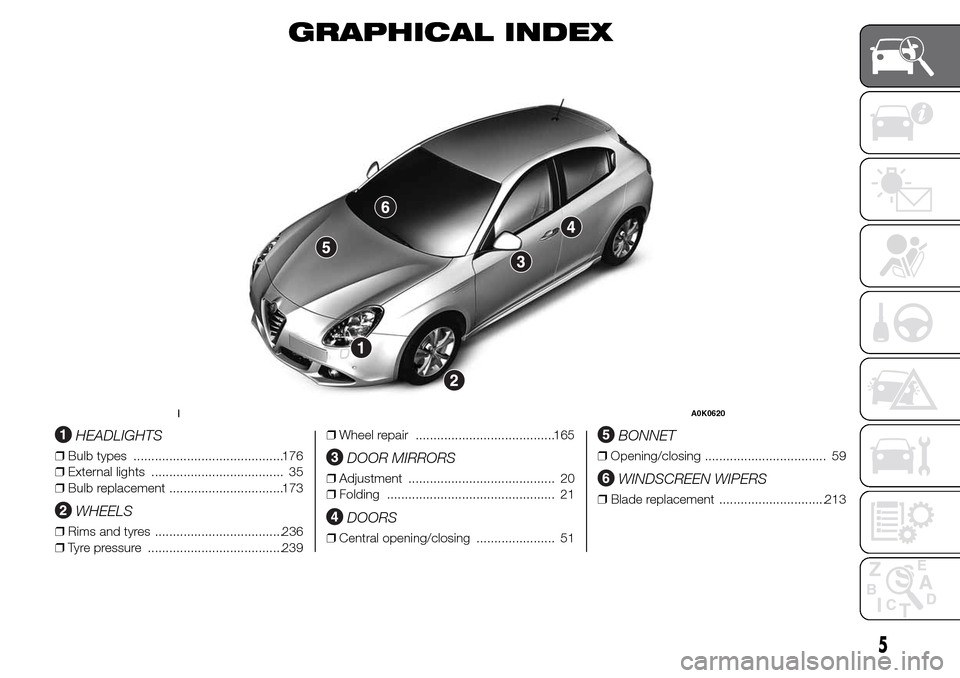
GRAPHICAL INDEX
.
HEADLIGHTS
❒Bulb types ..........................................176
❒External lights ..................................... 35
❒Bulb replacement ................................173
WHEELS
❒Rims and tyres ....................................236
❒Tyre pressure ......................................239❒Wheel repair .......................................165
DOOR MIRRORS
❒Adjustment ......................................... 20
❒Folding ............................................... 21
DOORS
❒Central opening/closing ...................... 51
BONNET
❒Opening/closing .................................. 59
WINDSCREEN WIPERS
❒Blade replacement ..............................213
1A0K0620
5
Page 18 of 288
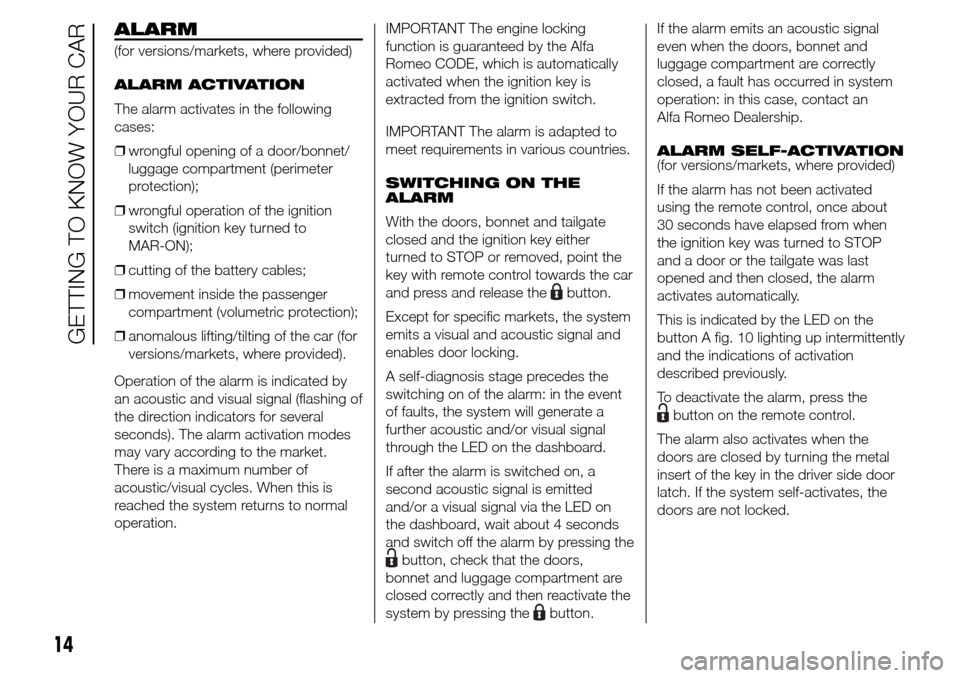
ALARM
(for versions/markets, where provided)
ALARM ACTIVATION
The alarm activates in the following
cases:
❒wrongful opening of a door/bonnet/
luggage compartment (perimeter
protection);
❒wrongful operation of the ignition
switch (ignition key turned to
MAR-ON);
❒cutting of the battery cables;
❒movement inside the passenger
compartment (volumetric protection);
❒anomalous lifting/tilting of the car (for
versions/markets, where provided).
Operation of the alarm is indicated by
an acoustic and visual signal (flashing of
the direction indicators for several
seconds). The alarm activation modes
may vary according to the market.
There is a maximum number of
acoustic/visual cycles. When this is
reached the system returns to normal
operation.IMPORTANT The engine locking
function is guaranteed by the Alfa
Romeo CODE, which is automatically
activated when the ignition key is
extracted from the ignition switch.
IMPORTANT The alarm is adapted to
meet requirements in various countries.
SWITCHING ON THE
ALARM
With the doors, bonnet and tailgate
closed and the ignition key either
turned to STOP or removed, point the
key with remote control towards the car
and press and release the
button.
Except for specific markets, the system
emits a visual and acoustic signal and
enables door locking.
A self-diagnosis stage precedes the
switching on of the alarm: in the event
of faults, the system will generate a
further acoustic and/or visual signal
through the LED on the dashboard.
If after the alarm is switched on, a
second acoustic signal is emitted
and/or a visual signal via the LED on
the dashboard, wait about 4 seconds
and switch off the alarm by pressing the
button, check that the doors,
bonnet and luggage compartment are
closed correctly and then reactivate the
system by pressing the
button.If the alarm emits an acoustic signal
even when the doors, bonnet and
luggage compartment are correctly
closed, a fault has occurred in system
operation: in this case, contact an
Alfa Romeo Dealership.
ALARM SELF-ACTIVATION
(for versions/markets, where provided)
If the alarm has not been activated
using the remote control, once about
30 seconds have elapsed from when
the ignition key was turned to STOP
and a door or the tailgate was last
opened and then closed, the alarm
activates automatically.
This is indicated by the LED on the
button A fig. 10 lighting up intermittently
and the indications of activation
described previously.
To deactivate the alarm, press the
button on the remote control.
The alarm also activates when the
doors are closed by turning the metal
insert of the key in the driver side door
latch. If the system self-activates, the
doors are not locked.
14
GETTING TO KNOW YOUR CAR
Page 63 of 288
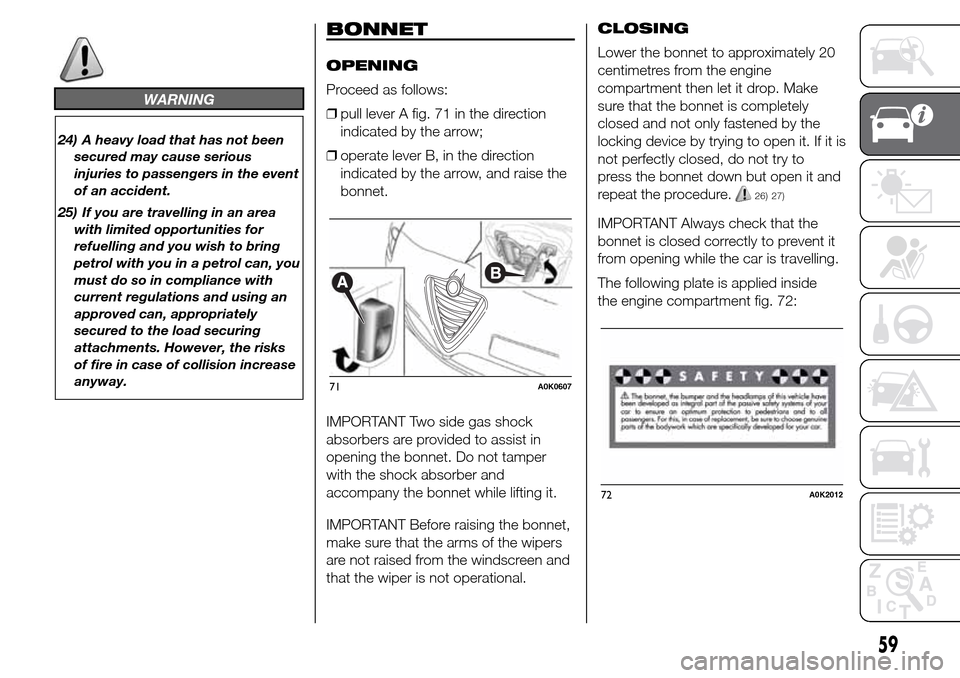
WARNING
24) A heavy load that has not been
secured may cause serious
injuries to passengers in the event
of an accident.
25) If you are travelling in an area
with limited opportunities for
refuelling and you wish to bring
petrol with you in a petrol can, you
must do so in compliance with
current regulations and using an
approved can, appropriately
secured to the load securing
attachments. However, the risks
of fire in case of collision increase
anyway.
BONNET
OPENING
Proceed as follows:
❒pull lever A fig. 71 in the direction
indicated by the arrow;
❒operate lever B, in the direction
indicated by the arrow, and raise the
bonnet.
IMPORTANT Two side gas shock
absorbers are provided to assist in
opening the bonnet. Do not tamper
with the shock absorber and
accompany the bonnet while lifting it.
IMPORTANT Before raising the bonnet,
make sure that the arms of the wipers
are not raised from the windscreen and
that the wiper is not operational.CLOSING
Lower the bonnet to approximately 20
centimetres from the engine
compartment then let it drop. Make
sure that the bonnet is completely
closed and not only fastened by the
locking device by trying to open it. If it is
not perfectly closed, do not try to
press the bonnet down but open it and
repeat the procedure.
26) 27)
IMPORTANT Always check that the
bonnet is closed correctly to prevent it
from opening while the car is travelling.
The following plate is applied inside
the engine compartment fig. 72:
71A0K0607
72A0K2012
59
Page 64 of 288
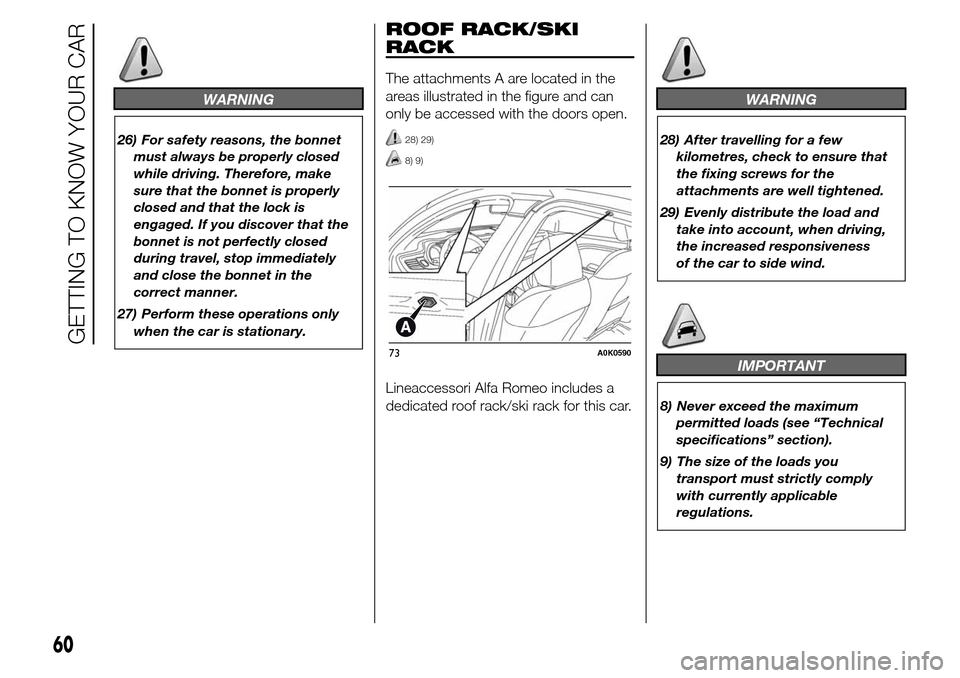
WARNING
26) For safety reasons, the bonnet
must always be properly closed
while driving. Therefore, make
sure that the bonnet is properly
closed and that the lock is
engaged. If you discover that the
bonnet is not perfectly closed
during travel, stop immediately
and close the bonnet in the
correct manner.
27) Perform these operations only
when the car is stationary.
ROOF RACK/SKI
RACK
The attachments A are located in the
areas illustrated in the figure and can
only be accessed with the doors open.
28) 29)
8) 9)
Lineaccessori Alfa Romeo includes a
dedicated roof rack/ski rack for this car.
WARNING
28) After travelling for a few
kilometres, check to ensure that
the fixing screws for the
attachments are well tightened.
29) Evenly distribute the load and
take into account, when driving,
the increased responsiveness
of the car to side wind.
IMPORTANT
8) Never exceed the maximum
permitted loads (see “Technical
specifications” section).
9) The size of the loads you
transport must strictly comply
with currently applicable
regulations.
73A0K0590
60
GETTING TO KNOW YOUR CAR
Page 76 of 288
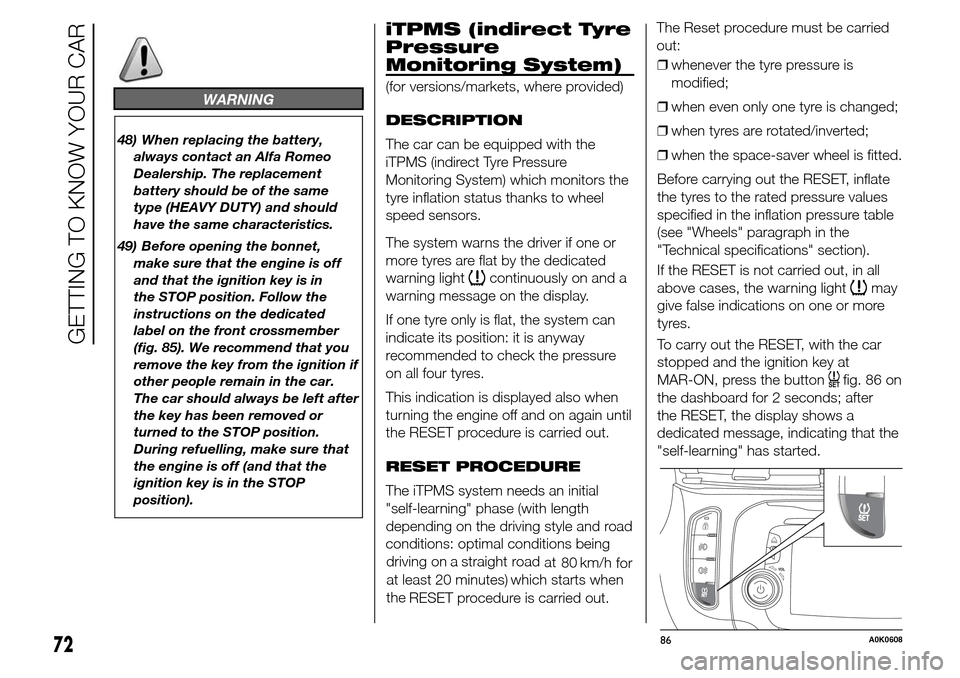
WARNING
48) When replacing the battery,
always contact an Alfa Romeo
Dealership. The replacement
battery should be of the same
type (HEAVY DUTY) and should
have the same characteristics.
49) Before opening the bonnet,
make sure that the engine is off
and that the ignition key is in
the STOP position. Follow the
instructions on the dedicated
label on the front crossmember
(fig. 85). We recommend that you
remove the key from the ignition if
other people remain in the car.
The car should always be left after
the key has been removed or
turned to the STOP position.
During refuelling, make sure that
the engine is off (and that the
ignition key is in the STOP
position).
iTPMS (indirect Tyre
Pressure
Monitoring System)
(for versions/markets, where provided)
DESCRIPTION
The car can be equipped with the
iTPMS (indirect Tyre Pressure
Monitoring System) which monitors the
tyre inflation status thanks to wheel
speed sensors.
The system warns the driver if one or
more tyres are flat by the dedicated
warning light
continuously on and a
warning message on the display.
If one tyre only is flat, the system can
indicate its position: it is anyway
recommended to check the pressure
on all four tyres.
This indication is displayed also when
turning the engine off and on again until
the RESET procedure is carried out.
RESET PROCEDURE
The iTPMS system needs an initial
"self-learning" phase (with length
depending on the driving style and road
conditions: optimal conditions being
RESET procedure is carried out.❒whenever the tyre pressure is
modified;
❒when even only one tyre is changed;
❒when tyres are rotated/inverted;
❒when the space-saver wheel is fitted.
Before carrying out the RESET, inflate
the tyres to the rated pressure values
specified in the inflation pressure table
(see "Wheels" paragraph in the
"Technical specifications" section).
If the RESET is not carried out, in all
above cases, the warning lightmay
give false indications on one or more
tyres.
To carry out the RESET, with the car
stopped and the ignition key at
MAR-ON, press the button
fig. 86 on
the dashboard for 2 seconds; after
the RESET, the display shows a
dedicated message, indicating that the
"self-learning" has started.
86A0K060872
GETTING TO KNOW YOUR CAR
The Reset procedure must be carried
out:
which starts when driving
on
a
straight
road
at
80
km/h
for
at least 20 minutes)
the
Page 110 of 288
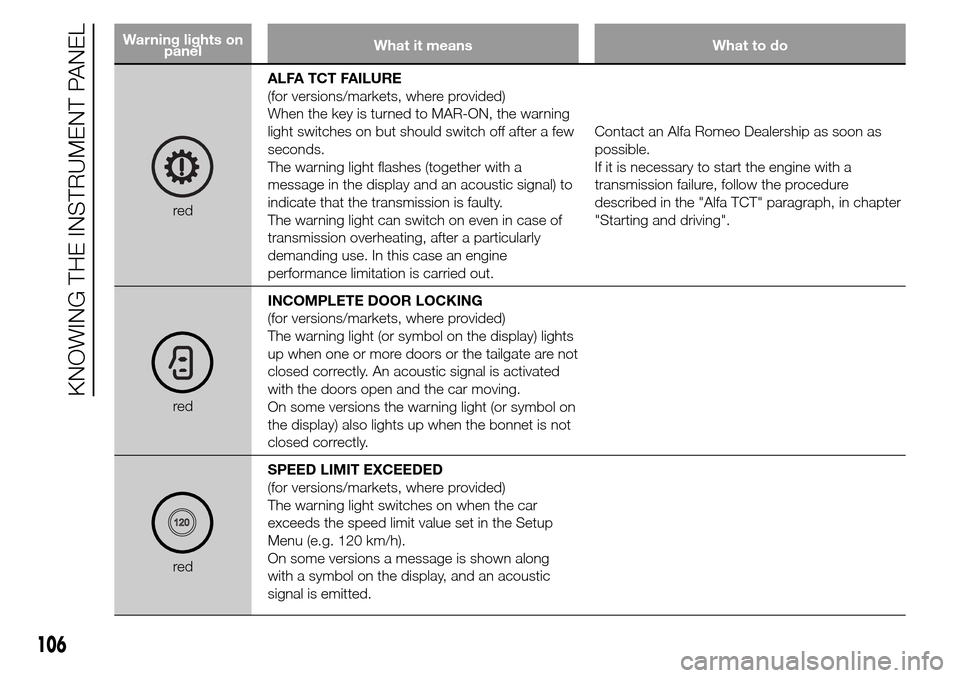
Warning lights on
panelWhat it means What to do
redALFA TCT FAILURE
(for versions/markets, where provided)
When the key is turned to MAR-ON, the warning
light switches on but should switch off after a few
seconds.
The warning light flashes (together with a
message in the display and an acoustic signal) to
indicate that the transmission is faulty.
The warning light can switch on even in case of
transmission overheating, after a particularly
demanding use. In this case an engine
performance limitation is carried out.Contact an Alfa Romeo Dealership as soon as
possible.
If it is necessary to start the engine with a
transmission failure, follow the procedure
described in the "Alfa TCT" paragraph, in chapter
"Starting and driving".
redINCOMPLETE DOOR LOCKING
(for versions/markets, where provided)
The warning light (or symbol on the display) lights
up when one or more doors or the tailgate are not
closed correctly. An acoustic signal is activated
with the doors open and the car moving.
On some versions the warning light (or symbol on
the display) also lights up when the bonnet is not
closed correctly.
redSPEED LIMIT EXCEEDED
(for versions/markets, where provided)
The warning light switches on when the car
exceeds the speed limit value set in the Setup
Menu (e.g. 120 km/h).
On some versions a message is shown along
with a symbol on the display, and an acoustic
signal is emitted.
106
KNOWING THE INSTRUMENT PANEL
Page 220 of 288
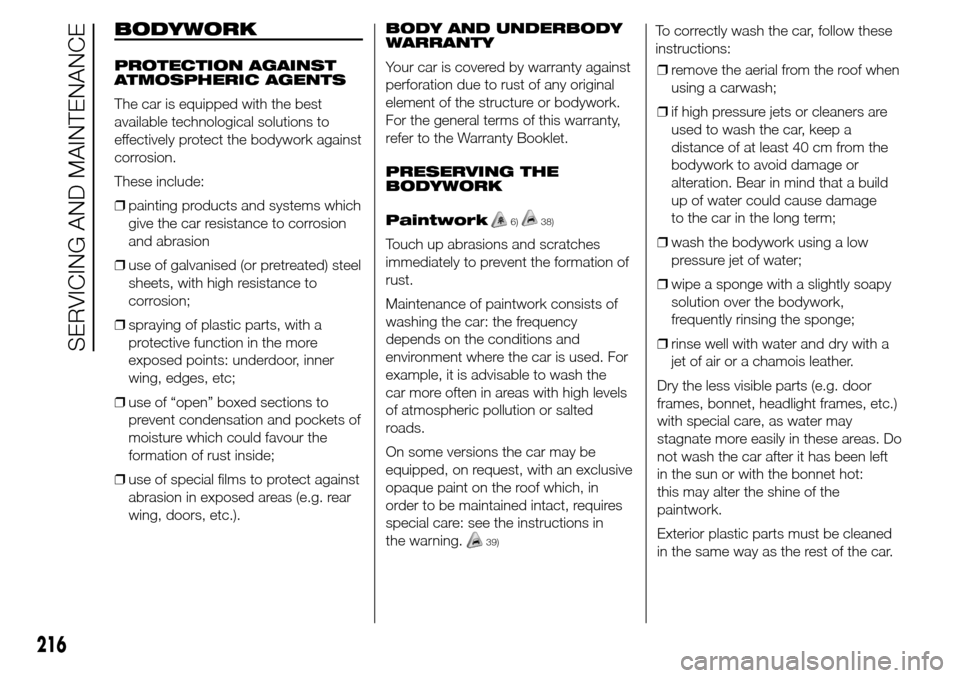
BODYWORK
PROTECTION AGAINST
ATMOSPHERIC AGENTS
The car is equipped with the best
available technological solutions to
effectively protect the bodywork against
corrosion.
These include:
❒painting products and systems which
give the car resistance to corrosion
and abrasion
❒use of galvanised (or pretreated) steel
sheets, with high resistance to
corrosion;
❒spraying of plastic parts, with a
protective function in the more
exposed points: underdoor, inner
wing, edges, etc;
❒use of “open” boxed sections to
prevent condensation and pockets of
moisture which could favour the
formation of rust inside;
❒use of special films to protect against
abrasion in exposed areas (e.g. rear
wing, doors, etc.).BODY AND UNDERBODY
WARRANTY
Your car is covered by warranty against
perforation due to rust of any original
element of the structure or bodywork.
For the general terms of this warranty,
refer to the Warranty Booklet.
PRESERVING THE
BODYWORK
Paintwork
6)38)
Touch up abrasions and scratches
immediately to prevent the formation of
rust.
Maintenance of paintwork consists of
washing the car: the frequency
depends on the conditions and
environment where the car is used. For
example, it is advisable to wash the
car more often in areas with high levels
of atmospheric pollution or salted
roads.
On some versions the car may be
equipped, on request, with an exclusive
opaque paint on the roof which, in
order to be maintained intact, requires
special care: see the instructions in
the warning.
39)
To correctly wash the car, follow these
instructions:
❒remove the aerial from the roof when
using a carwash;
❒if high pressure jets or cleaners are
used to wash the car, keep a
distance of at least 40 cm from the
bodywork to avoid damage or
alteration. Bear in mind that a build
up of water could cause damage
to the car in the long term;
❒wash the bodywork using a low
pressure jet of water;
❒wipe a sponge with a slightly soapy
solution over the bodywork,
frequently rinsing the sponge;
❒rinse well with water and dry with a
jet of air or a chamois leather.
Dry the less visible parts (e.g. door
frames, bonnet, headlight frames, etc.)
with special care, as water may
stagnate more easily in these areas. Do
not wash the car after it has been left
in the sun or with the bonnet hot:
this may alter the shine of the
paintwork.
Exterior plastic parts must be cleaned
in the same way as the rest of the car.
216
SERVICING AND MAINTENANCE
Page 281 of 288
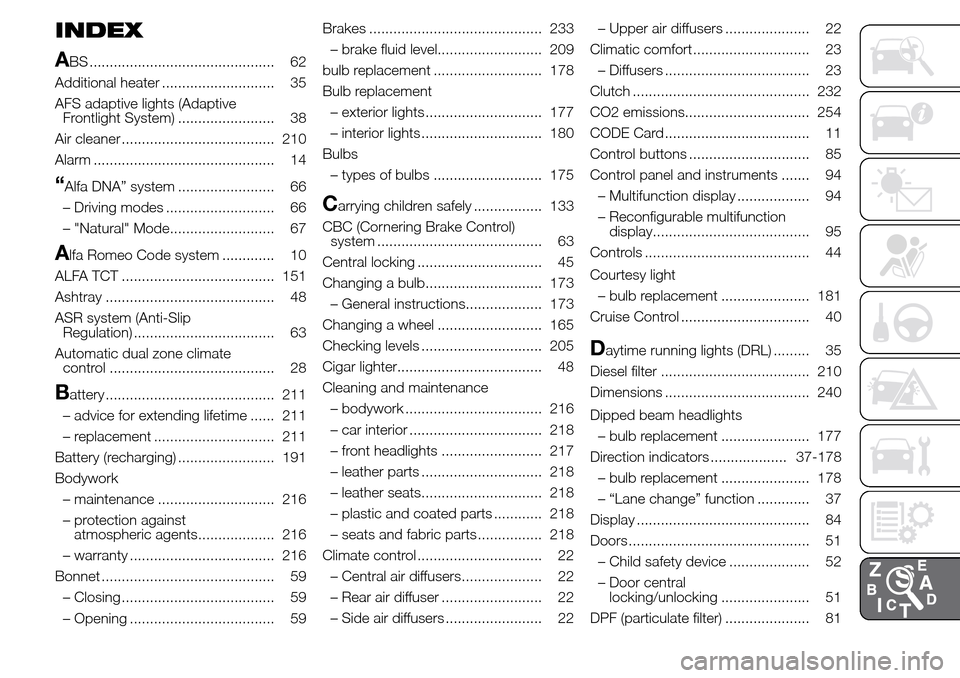
INDEX
A
BS .............................................. 62
Additional heater ............................ 35
AFS adaptive lights (Adaptive
Frontlight System) ........................ 38
Air cleaner ...................................... 210
Alarm ............................................. 14
“Alfa DNA” system ........................ 66
– Driving modes ........................... 66
– "Natural" Mode.......................... 67
Alfa Romeo Code system ............. 10
ALFA TCT ...................................... 151
Ashtray .......................................... 48
ASR system (Anti-Slip
Regulation) ................................... 63
Automatic dual zone climate
control ......................................... 28
Battery .......................................... 211
– advice for extending lifetime ...... 211
– replacement .............................. 211
Battery (recharging) ........................ 191
Bodywork
– maintenance ............................. 216
– protection against
atmospheric agents................... 216
– warranty .................................... 216
Bonnet ........................................... 59
– Closing ...................................... 59
– Opening .................................... 59Brakes ........................................... 233
– brake fluid level.......................... 209
bulb replacement ........................... 178
Bulb replacement
– exterior lights ............................. 177
– interior lights .............................. 180
Bulbs
– types of bulbs ........................... 175
Carrying children safely ................. 133
CBC (Cornering Brake Control)
system ......................................... 63
Central locking ............................... 45
Changing a bulb............................. 173
– General instructions................... 173
Changing a wheel .......................... 165
Checking levels .............................. 205
Cigar lighter.................................... 48
Cleaning and maintenance
– bodywork .................................. 216
– car interior ................................. 218
– front headlights ......................... 217
– leather parts .............................. 218
– leather seats.............................. 218
– plastic and coated parts ............ 218
– seats and fabric parts ................ 218
Climate control ............................... 22
– Central air diffusers.................... 22
– Rear air diffuser ......................... 22
– Side air diffusers ........................ 22– Upper air diffusers ..................... 22
Climatic comfort ............................. 23
– Diffusers .................................... 23
Clutch ............................................ 232
CO2 emissions............................... 254
CODE Card .................................... 11
Control buttons .............................. 85
Control panel and instruments ....... 94
– Multifunction display .................. 94
– Reconfigurable multifunction
display....................................... 95
Controls ......................................... 44
Courtesy light
– bulb replacement ...................... 181
Cruise Control ................................ 40
Daytime running lights (DRL) ......... 35
Diesel filter ..................................... 210
Dimensions .................................... 240
Dipped beam headlights
– bulb replacement ...................... 177
Direction indicators ................... 37-178
– bulb replacement ...................... 178
– “Lane change” function ............. 37
Display ........................................... 84
Doors ............................................. 51
– Child safety device .................... 52
– Door central
locking/unlocking ...................... 51
DPF (particulate filter) ..................... 81